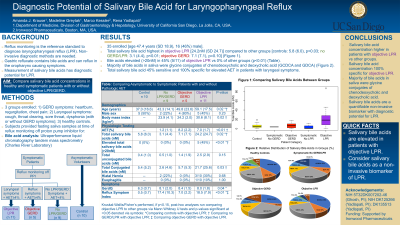Monday Poster Session
Category: Esophagus
P1808 - Diagnostic Potential of Salivary Bile Acid for Laryngopharyngeal Reflux
Monday, October 23, 2023
10:30 AM - 4:15 PM PT
Location: Exhibit Hall

Has Audio

Amanda J. Krause, MD
University of California San Diego
La Jolla, CA
Presenting Author(s)
Award: Presidential Poster Award
Amanda J. Krause, MD1, Maddi Greytak, BA2, Marco Kessler, PhD3, Rena Yadlapati, MD, MS4
1University of California San Diego, La Jolla, CA; 2UC San Diego Health, La Jolla, CA; 3Ironwood Pharmaceuticals, Boston, MA; 4University of California San Diego, San Diego, CA
Introduction: Reflux monitoring is the reference standard for diagnosing laryngopharyngeal reflux (LPR) and non-invasive diagnostic methods are needed. Gastric refluxate contains bile acids, which can reflux in the oropharynx in LPR and cause symptoms; therefore, measurement of salivary bile acids has potential for diagnosing LPR. The aim of this study was to measure and compare salivary bile acid concentrations across healthy controls and symptomatic patients with or without objective evidence of LPR/GERD.
Methods: This prospective study enrolled adults over one year into 3 groups: 1) GERD symptoms: heartburn, regurgitation, and/or chest pain; 2) LPR symptoms: cough, throat clearing, sore throat, and/or dysphonia; 3) healthy volunteers. Participants provided 2 saliva samples for bile acid analysis using ultraperformance liquid chromatography tandem mass spectrometry methods (Charles River Laboratory) and pepsin analysis using Peptest lateral flow device (RD Biomed Ltd.). Symptomatic patients underwent reflux monitoring off acid suppression [acid exposure time (AET) < 4% normal and ≥ 4% elevated]. Primary analysis compared salivary bile acids between healthy volunteers, symptomatic with normal AET (no GERD/LPR), GERD symptoms with elevated AET (objective GERD), and LPR symptoms with elevated AET (objective LPR).
Results: 35 participants were enrolled [mean age 47.4 years (SD 18.9), 19 (54%) female]: 10 healthy volunteers, 6 GERD symptoms, 19 LPR symptoms. Of the symptomatic groups: 9 were no GERD/LPR, 5 objective GERD, and 11 objective LPR. Total salivary bile acid concentration was highest in the objective LPR group (24.2nM (SD 24.7)) compared to other groups (no GERD/LPR [3.1 (4.4); p=0.04]; healthy controls [5.8 (6.0)]; objective GERD [7.1 (7.1)]) (figure). Bile acids were elevated ( > 20nM) in 45% (5/11) of the objective LPR group compared to 0% of the other 3 groups (p < 0.01) (table).
Among those with LPR symptoms, AET was elevated in 5/5 (100%) with elevated total bile acid versus 6/14 (43%) with normal total bile acids (p=0.04). Total salivary bile acid was 45% sensitive and 100% specific for elevated AET.
Discussion: Salivary bile acid concentration was higher among patients with objective LPR versus other groups and was 100% specific for objective LPR (elevated acid exposure) among patients with laryngeal symptoms. Salivary bile acids are a quantifiable non-invasive biomarker with diagnostic potential for LPR.

Disclosures:
Amanda J. Krause, MD1, Maddi Greytak, BA2, Marco Kessler, PhD3, Rena Yadlapati, MD, MS4. P1808 - Diagnostic Potential of Salivary Bile Acid for Laryngopharyngeal Reflux, ACG 2023 Annual Scientific Meeting Abstracts. Vancouver, BC, Canada: American College of Gastroenterology.
Amanda J. Krause, MD1, Maddi Greytak, BA2, Marco Kessler, PhD3, Rena Yadlapati, MD, MS4
1University of California San Diego, La Jolla, CA; 2UC San Diego Health, La Jolla, CA; 3Ironwood Pharmaceuticals, Boston, MA; 4University of California San Diego, San Diego, CA
Introduction: Reflux monitoring is the reference standard for diagnosing laryngopharyngeal reflux (LPR) and non-invasive diagnostic methods are needed. Gastric refluxate contains bile acids, which can reflux in the oropharynx in LPR and cause symptoms; therefore, measurement of salivary bile acids has potential for diagnosing LPR. The aim of this study was to measure and compare salivary bile acid concentrations across healthy controls and symptomatic patients with or without objective evidence of LPR/GERD.
Methods: This prospective study enrolled adults over one year into 3 groups: 1) GERD symptoms: heartburn, regurgitation, and/or chest pain; 2) LPR symptoms: cough, throat clearing, sore throat, and/or dysphonia; 3) healthy volunteers. Participants provided 2 saliva samples for bile acid analysis using ultraperformance liquid chromatography tandem mass spectrometry methods (Charles River Laboratory) and pepsin analysis using Peptest lateral flow device (RD Biomed Ltd.). Symptomatic patients underwent reflux monitoring off acid suppression [acid exposure time (AET) < 4% normal and ≥ 4% elevated]. Primary analysis compared salivary bile acids between healthy volunteers, symptomatic with normal AET (no GERD/LPR), GERD symptoms with elevated AET (objective GERD), and LPR symptoms with elevated AET (objective LPR).
Results: 35 participants were enrolled [mean age 47.4 years (SD 18.9), 19 (54%) female]: 10 healthy volunteers, 6 GERD symptoms, 19 LPR symptoms. Of the symptomatic groups: 9 were no GERD/LPR, 5 objective GERD, and 11 objective LPR. Total salivary bile acid concentration was highest in the objective LPR group (24.2nM (SD 24.7)) compared to other groups (no GERD/LPR [3.1 (4.4); p=0.04]; healthy controls [5.8 (6.0)]; objective GERD [7.1 (7.1)]) (figure). Bile acids were elevated ( > 20nM) in 45% (5/11) of the objective LPR group compared to 0% of the other 3 groups (p < 0.01) (table).
Among those with LPR symptoms, AET was elevated in 5/5 (100%) with elevated total bile acid versus 6/14 (43%) with normal total bile acids (p=0.04). Total salivary bile acid was 45% sensitive and 100% specific for elevated AET.
Discussion: Salivary bile acid concentration was higher among patients with objective LPR versus other groups and was 100% specific for objective LPR (elevated acid exposure) among patients with laryngeal symptoms. Salivary bile acids are a quantifiable non-invasive biomarker with diagnostic potential for LPR.

Figure: Figure: Comparing salivary bile acids between symptomatic cohorts and by AET. Panel A compares salivary bile acids between groups. Panel B compares salivary bile acids to AET.
Disclosures:
Amanda Krause indicated no relevant financial relationships.
Maddi Greytak indicated no relevant financial relationships.
Marco Kessler: Ironwood Pharmaceuticals – Consultant.
Rena Yadlapati: Ironwood – Grant/Research Support. Medscape – Consultant. Medtronic – Consultant. Phathom – Consultant. Reckitt Benckiser Healthcare Ltd – Consultant. RJS Mediagnostix – Advisory Committee/Board Member, Stock Options. StatLinkMD – Consultant.
Amanda J. Krause, MD1, Maddi Greytak, BA2, Marco Kessler, PhD3, Rena Yadlapati, MD, MS4. P1808 - Diagnostic Potential of Salivary Bile Acid for Laryngopharyngeal Reflux, ACG 2023 Annual Scientific Meeting Abstracts. Vancouver, BC, Canada: American College of Gastroenterology.

